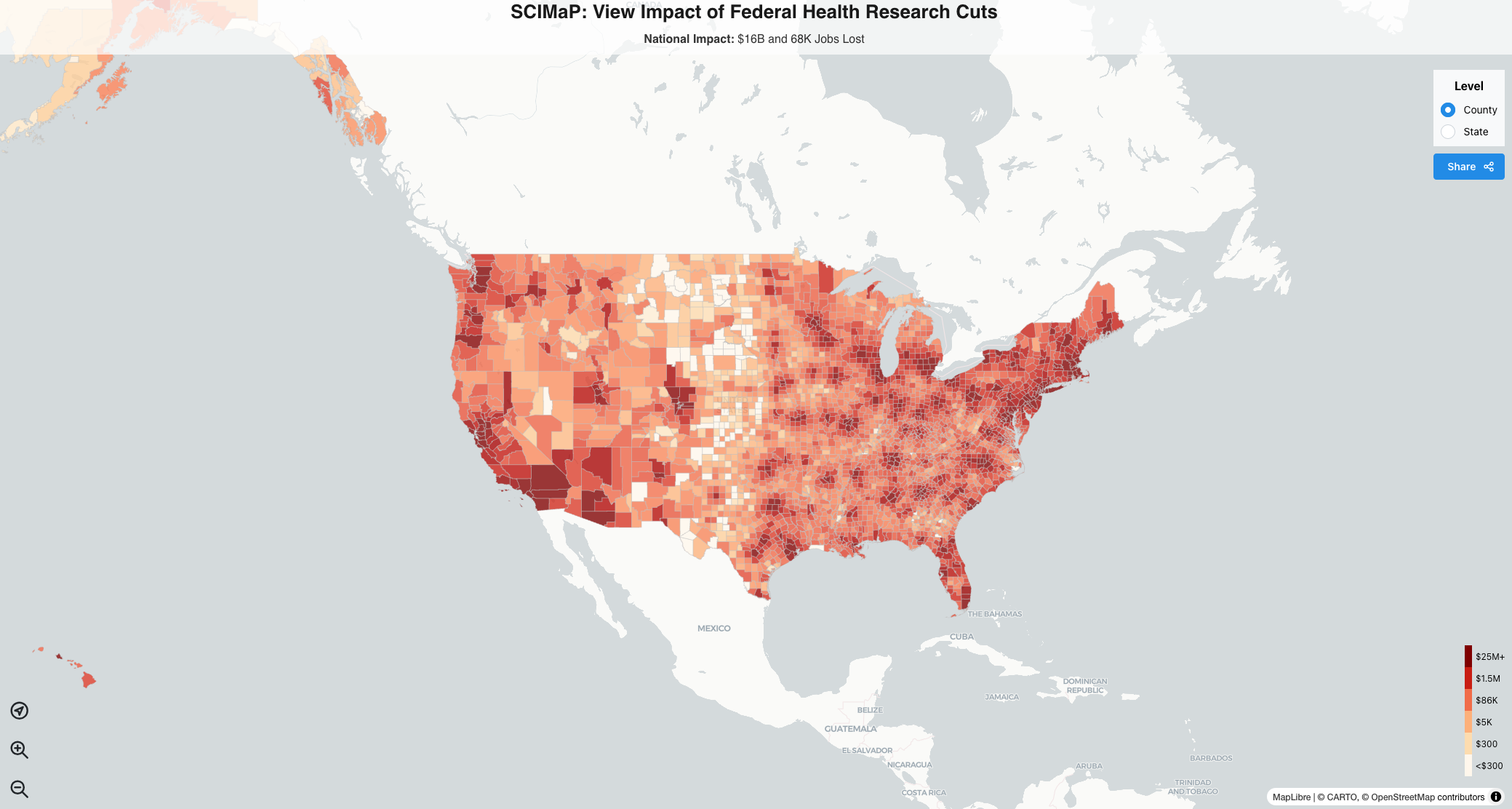In the wake of sweeping cuts to federal funding for scientific research, including a proposal to reduce support for medical research nationwide, an interdisciplinary team of academic researchers from the University of Pennsylvania and four other institutions developed an interactive, data-driven map to communicate the impact these cuts would have at national, state, and county levels.
The Science & Community Impacts Mapping Project (SCIMaP) shows how proposed federal funding cuts lead to reduced economic activity and job losses nationwide. The SCIMaP team’s analysis of across-the-board reductions to research infrastructure support for National Institutes of Health (NIH) grants, known as indirect costs, shows an estimated $16 billion in economic loss and 68,000 jobs lost nationwide.
 “The NIH funds crucial research to address leading health problems like cancer, diabetes, dementia, heart disease, infectious diseases, mental illness, and more,” said project co-lead Alyssa Sinclair, Joan Bossert Postdoctoral Fellow at the Annenberg Public Policy Center (APPC) of the University of Pennsylvania and the Penn Center for Science, Sustainability, and the Media. Sinclair, who is also a postdoctoral fellow at the Communication Neuroscience Lab at the Annenberg School for Communication, added that research innovations have a big impact on our daily lives. “Research innovations directly improve our daily lives by curing and preventing diseases, unlocking new technologies, and improving the safety of our food, water and environments.”
“The NIH funds crucial research to address leading health problems like cancer, diabetes, dementia, heart disease, infectious diseases, mental illness, and more,” said project co-lead Alyssa Sinclair, Joan Bossert Postdoctoral Fellow at the Annenberg Public Policy Center (APPC) of the University of Pennsylvania and the Penn Center for Science, Sustainability, and the Media. Sinclair, who is also a postdoctoral fellow at the Communication Neuroscience Lab at the Annenberg School for Communication, added that research innovations have a big impact on our daily lives. “Research innovations directly improve our daily lives by curing and preventing diseases, unlocking new technologies, and improving the safety of our food, water and environments.”
In recent years, more than $35 billion in NIH-funded medical research has been made possible annually through grant support to universities, hospitals and research institutes in communities across the U.S.
“Science transforms our world; however, the process of doing science and the impacts of scientific research are often hidden from view,” said project co-lead Joshua Weitz, Professor of Biology and Clark Leadership Chair in Data Analytics at the University of Maryland, with a joint appointment in the University of Maryland Institute for Health Computing. “Through interactive, data-driven visualizations, we aim to help Americans explore how science and health research fuels the economy, supports jobs and improves health outcomes.”
The team behind the project also includes researchers at the University of Utah, Georgia Institute of Technology and University of Oregon.
Although less than 1% of the federal budget goes to the NIH, the investment has a big impact. The United for Medical Research coalition estimates that every $1 invested in scientific research through the NIH produces $2.56 in new economic activity, a more than 250% gain in investment. Further, NIH research supports over 400,000 jobs across the U.S. Research funded by the NIH has led to major breakthroughs, including the prevention, treatment, and cures for cancer, heart disease, and type 1 diabetes.

The proposed NIH federal funding cuts would greatly reduce the funding that covers the indirect costs of research already committed in grants. These funds pay for essential facilities, special equipment, skilled staff and safety checks that are shared across many research projects. Currently, the effective indirect cost rate is approximately 42% at institutions nationwide. In February 2025, the NIH announced a policy to cut this by more than half, reducing indirect costs to a flat rate of 15%. Medical research would be slowed by drastic cuts in total research funding, according to Heather Pierce, senior director for science policy at the Association of American Medical Colleges, in a recent interview with the New York Times.
“Medical and scientific breakthroughs supported by the U.S. government impact all our lives,” said Emily Falk, Professor and Vice Dean of Penn’s Annenberg School for Communication (ASC), and director of APPC’s Climate Communication Division. “Research innovations are at the core of many things that enhance our daily lives and keep us safer.”
She added that the U.S. government’s investment in research has made the nation a leader in the world. “SCIMaP shows what’s at stake for local economies and the future of innovation in our communities,” Falk said.
In addition to Sinclair, Weitz, and Falk, the team behind SCIMaP includes Danielle Cosme, scientific director of APPC’s Climate Communication Division, along with Mallory Harris (University of Maryland), Clio Andris (Georgia Institute of Technology), Angela Fagerlin (University of Utah), Ellen Peters (University of Oregon) and other researchers at institutions across the country.
This story was originally posted at the Annenberg School for Communication. To learn more about the project, read the full story at ASC.

